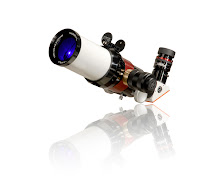 For those who have googled "what's an etalon?" the returned results outlining complex looking optical equations, mathmatical relationships, and technical references probably didn't do much to answer the question. Unless you are an Optical Physicist of course. (I love that stuff)
For those who have googled "what's an etalon?" the returned results outlining complex looking optical equations, mathmatical relationships, and technical references probably didn't do much to answer the question. Unless you are an Optical Physicist of course. (I love that stuff)An etalon refers to an interference type filter typically used in Solar Telescopes because of the desire for an ultra narrow bandpass.
An etalon is probably one of the simplest designs for an optical filter utilizing some of the most precise optical specifications. Due to it both being simple and the need for precision, there are many compromises that can influence the quality of an etalon filter.
An etalon is comprised of 2 flat and parallel optical surface that have been optically coated with a high reflective dielectric layer with the high reflector layer peaking at the desired bandpass point for best results. These optical surfaces are seperated by a gap. This gap can be either air or a solid material. The light resonates in the gap by internal reflection off the highly reflective layers on the surfaces. Thru interference at this gap, only light meeting the correct angle of incidence to the surface and is not "interfered with" can pass, all other light is lost.
The main parameters that define an etalon are:
Bandpass: This is the width of the curve that defines the transmitance of the filter at 50% of the total transmision of the filter. An etalon's transmission has a broad base and a sharp peak. Typically the peak transmission should be between 80-90%, so the bandpass of the etalon will be measured between the 40-45% points. For Solar applications it is generally accepted that the lower this number, the better. Typical Solar Etalons have a bandpass of <1.0.
Bandpass is a function of the gap size between the high reflector plates. The larger the gap size, the narrower the bandpass.
Bandpass is also a function of the reflectivity of the etalon high reflector plates. The higher the reflectivity, the narrower the bandpass.
Peak Transmission: In order to obtain good contrast it is important to maximize the peak transmission while minimizing the "out of band" transmission. To explain this statement, a surface that had zero reflectivity would have 100% peak transmission. However, because there is no reflectivity in the cavity, there is no interference, and thus, no filter (bandpass). A surface with 100% R would reflect all light before it entered the cavity, thus having zero T. The compromise is somewhere in between..
Peak transmission is a function of the reflectivity of the surfaces. The higher the R, the lower the peak transmission. (in reality it isn't quite that simple)
Free Spectral Range: The free spectral range is defined as the gap between the peaks of transmission plotted againt wavelength. Huh?? An etalon produces a "comb" of peak transmission across a broad range of the visible spectrum. This would be like a hair comb. One tooth of the comb would represent a peak transmission. This comb would then be missing about 12-14 teeth before the next peak transmission, or tooth. In our case the FSR is more than 10 Angstroms. This becomes important to our ability to block the unwanted peak transmissions utilizing simpler filters. The narrower the FSR, the harder it is to block the transmissions you don't want. Letting another leak transmission thru will wash out the details.
FSR is a function of gap size. The narrower the gap, the wider the FSR.
Optical Flatness and Parallism: Probably the most critical aspects of the etalon performance.... To put it simply, the better the flatness and the parallism, the better the etalon.
The quality of an etalon is very much the function of precision polishing and gap maintainance.
When it comes to the specification of a Solar Telescope I often hear the bandpass stated out as a matter of fact. However, this bandpass is typically the theoretical value of the system based on the known paramaters of reflectivity, gap size, and optical flatness. What one should realize is that bandpass is not the all defining specification of a quality system.
I could quite easily manufacture a 0.3A bandpass filter and everyone would be happy.. Right??
Not if it's performance was any factor.. An etalon with a peak transmission of 40% and a FSR of 4A is quite easy to manufacture. But I assure you, you wouldn't want it in your scope.
When it comes to Etalons there are typically a few things to look at.. The bandpass, is of course, of very high concern as long as all other aspects of the optical system have been addressed. An FSR of greater than 10A is required in order to prevent out of band leaks. (the camel peaking it's nose under the tent) a phrase I liked when I heard it.
Peak T is also important as long as it comes with a zero baseline. Signal to noise ratio is critical because it is what makes the brights bright, and the darks dark. No-one want to see a significant orange glow in the space around the Sun's image, this simply washes out the edge details.
Contrast is just as important as bandpass in my opinion. However, there really isn't any specification for contrast ratio.
End of Part 1
Next: How do we make them?


.gif)







